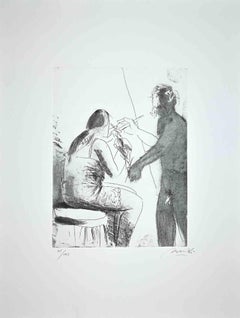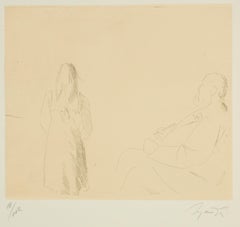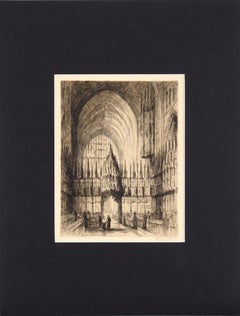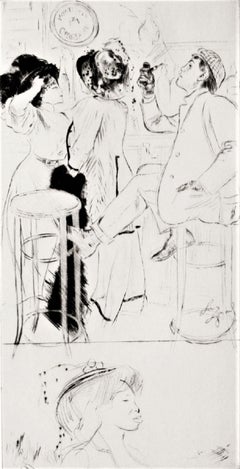Giacomo Manzú Interior Prints
to
2
Overall Width
to
Overall Height
to
1
1
66
108
79
46
30
2
2
2
2
2
1
1
2
1
1
2
Artist: Giacomo Manzú
In the Atelier - Etching by Giacomo Manzù - 1968
By Giacomo Manzú
Located in Roma, IT
In the Atelier is an original etching realized by Giacomo Manzù in 1968.
Hand Signed and numbered. Edition 26/125.
Excellent condition.
Giacomo Manzù (Bergamo, 1908- Ardea, 1991),...
Category
1960s Contemporary Giacomo Manzú Interior Prints
Materials
Etching
Painter and Model
By Giacomo Manzú
Located in Roma, IT
Painter and Model is an original artwork realized by Giacomo Manzù in 1964.
Hand signed on the lower right margin. Numbered on the lower left.
Edition of 102 copies (16/102), etch...
Category
1960s Modern Giacomo Manzú Interior Prints
Materials
Drypoint, Etching
Related Items
Chester Cathedral - Drypoint Etching in Ink on Paper
Located in Soquel, CA
Chester Cathedral - Drypoint Etching in Ink on Paper
Dramatic drypoint etching by J. Alphege Brewer (British, 1881-1946). This composition shows the interior of Chester Cathedral in Brewer's characteristic style - highly detailed and with strong contrast. The scene encompasses the cathedral from floor to ceiling, capturing the immense size of the building. There are several people in the scene which contribute to the sense of scale.
Signed by hand "J. Alphege Brewer" in the lower right corner.
Titled "Chester Cathedral" in plate, lower left corner.
Includes original card with artist's name.
Presented in a new black mat with foamcore backing.
Mat size: 16"H x 12"W
Paper size: 10.75"H x 7.75"W
James Alphege Brewer was well known in the early 20th century as a producer of color etchings of European cathedrals and other scenes of church, college, and community. He was born July 24, 1881, in the Kensington section of London, England, the son of Henry W. Brewer, noted artist of historical architecture and prominent convert to the Catholic Church, and the grandson of John Sherren Brewer, Jr., “the brilliant editor of the Calendar of Letters of Henry VIII.” His great uncle was E. Cobham Brewer, the polymath who compiled Brewer’s Dictionary of Phrase and Fable. Among his older siblings were the artist Henry C. Brewer and the organist and writer John Francis Brewer.
Brewer attended the Westminster School of Art in London, where his brother Henry also trained. In 1910, he married Florence Emma Lucas, an accomplished painter in oil and watercolor, whose father was the noted landscape artist George Lucas and whose great uncle was David Lucas, the famous engraver for John Constable. Florence's brothers Edwin and George assisted Brewer in the printing of Brewer's etchings.
Brewer exhibited at the Royal Academy (RA) and the Royal Institute of Painters in Watercolour (RI), at the Paris Salon of the Académie des Beaux-Arts, and in the shows of the Royal Cambrian Academy (RCA). He became an associate of the Royal Cambrian Academy in 1929 and a full member in the last two years of his life. He was also a member of the Hampstead Society of Artists, the Society of Graphic Art, and the Ealing Arts Club, where he was first Honorary Art Secretary and then Honorary Art Chairman. Most of Brewer's larger etchings were published by Alfred Bell...
Category
Early 20th Century Romantic Giacomo Manzú Interior Prints
Materials
Paper, Ink, Drypoint
$396 Sale Price
20% Off
H 16 in W 12 in D 0.25 in
Sportsmen
By Louis Legrand
Located in Storrs, CT
Sportsmen. 1908. Etching and drypoint. Exsteens 271.i/ii. 11 1/4 x 5 3/4 (sheet 17 3/8 x 12 1/4). Series: Les Bars. From the first state edition of 30 proofs with the remarque sketch...
Category
Early 1900s Post-Impressionist Giacomo Manzú Interior Prints
Materials
Drypoint, Etching
Don Juan
By Louis Icart
Located in Missouri, MO
Aquating Engraving
Image Size: approx. 20 1/4 x 13 3/8
Framed Size: 28 x 20.5 inches
Pencil Signed Lower Right
Louis Justin Laurent Icart was born in Toulouse in 1890 and died in Paris in 1950. He lived in New York City in the 1920s, where he became known for his Art-Deco color etchings of glamourous women.
He was first son of Jean and Elisabeth Icart and was officially named Louis Justin Laurent Icart. The use of his initials L.I. would be sufficient in this household. Therefore, from the moment of his birth he was dubbed 'Helli'. The Icart family lived modestly in a small brick home on rue Traversière-de-la-balance, in the culturally rich Southern French city of Toulouse, which was the home of many prominent writers and artists, the most famous being Henri de Toulouse-Lautrec.
Icart entered the l'Ecole Superieure de Commerce de Toulouse in order to continue his studies for a career in business, particularly banking (his father's profession). However, he soon discovered the play writings of Victor Hugo (1802-1885), which were to change the course of his life. Icart borrowed whatever books he could find by Hugo at the Toulouse library, devouring the tales, rich in both romantic imagery and the dilemmas of the human condition. It was through Icart's love of the theater that he developed a taste for all the arts, though the urge to paint was not as yet as strong for him as the urge to act.
It was not until his move to Paris in 1907 that Icart would concentrate on painting, drawing and the production of countless beautiful etchings, which have served (more than the other mediums) to indelibly preserve his name in twentieth century art history.
Art Deco, a term coined at the 1925 Paris Exposition des Arts Decoratifs, had taken its grip on the Paris of the 1920s. By the late 1920s Icart, working for both publications and major fashion and design studios, had become very successful, both artistically and financially. His etchings reached their height of brilliance in this era of Art Deco, and Icart had become the symbol of the epoch. Yet, although Icart has created for us a picture of Paris and New York life in the 1920s and 1930s, he worked in his own style, derived principally from the study of eighteenth-century French masters such as Jean Antoine Watteau, François Boucher and Jean Honoré Fragonard.
In Icart's drawings, one sees the Impressionists Degas...
Category
1920s Art Deco Giacomo Manzú Interior Prints
Materials
Engraving, Aquatint
Peter Doig, Fisherman (from Black Palms) - 2004, Etching, Signed Print
By Peter Doig
Located in Hamburg, DE
Peter Doig (born 1959 in Edinburgh)
Fisherman, 2004
Series: From the “Black Palms” portfolio
Medium: Etching in colors, on 250g/qm Zerkall paper
Medium: 53.5 × 38 cm (21 1/10 × 15 in...
Category
21st Century and Contemporary Contemporary Giacomo Manzú Interior Prints
Materials
Etching
$4,192
H 21.07 in W 14.97 in
HAMBURGER KNIEPPE
By Käthe Kollwitz
Located in Santa Monica, CA
KATHE KOLLWITZ (1867-1945)
HAMBURGER KNIEPPE, 1901) (K.58 IIIb)
Soft Ground Etching, Plate 9 ¾ x 8 ¼ sheet 10 ½ x 13 ¾. With the von de Becke blind stamp in the lower right. Prin...
Category
Early 1900s Expressionist Giacomo Manzú Interior Prints
Materials
Etching
Le Chat et Les Fleurs
By Édouard Manet
Located in Middletown, NY
Etching and aquatint on cream laid, watermarked Rives paper. 6 5/8 x 5 inches (167 x 126 mm). Sixth and final state, a posthumous impression. A fine, inky impression with full margin...
Category
1860s Realist Giacomo Manzú Interior Prints
Materials
Etching, Aquatint
Bernard Sanders, Head of Girl
Located in New York, NY
For a print that's nearly one hundred years old it feels very contemporary.
Signed in pencil; titled in lower margin in pencil.
Category
Early 20th Century American Modern Giacomo Manzú Interior Prints
Materials
Drypoint
The Sacristan
By Harry Morley
Located in New Orleans, LA
This image shows a cleric seated in a church sacristy surrounded by religious statues, croziers, various saints, statues and chalices. It is an origina...
Category
Early 20th Century Modern Giacomo Manzú Interior Prints
Materials
Engraving
Backlighting
By Paolo Ciampini
Located in New Orleans, LA
"Backlighting" was issued in an edition of 50.
Paolo Ciampini was born in Montopoli in Val d'Arno in 1941. After graduating from the Art Institute of Cascina (Pisa) in 1962, he com...
Category
1990s Contemporary Giacomo Manzú Interior Prints
Materials
Etching
Monstrosities of 1822; Plate 5
By George Cruikshank
Located in Middletown, NY
London: Thomas McLean, 1835. Third Edition. Etching with hand coloring in watercolor on cream wove paper, 9 1/2 x 13 3/4 inches (240 x 348 mm), full margins. With light, fresh color....
Category
Early 19th Century Victorian Giacomo Manzú Interior Prints
Materials
Watercolor, Etching
Monstrosities of 1824; Plate 7
By George Cruikshank
Located in Middletown, NY
London: Thomas McLean, 1835. Third Edition. Etching with hand coloring in watercolor on cream wove paper, 1818 (published August 1st, 1835) 9 1/2 x 13 3/4 inches (240 x 348 mm), full...
Category
Mid-19th Century Victorian Giacomo Manzú Interior Prints
Materials
Watercolor, Etching
In the cafeteria - Figurative Drypoint Print, Colorful, Polish Art
By Czeslaw Tumielewicz
Located in Warsaw, PL
CZESLAW TUMIELEWICZ (b. 1942)
In 1968, he studied at the Architecture faculty of Gdank, before continuing his course at the Technical University in the same city, and then he taught ...
Category
Early 2000s Contemporary Giacomo Manzú Interior Prints
Materials
Paper, Drypoint, Watercolor
$335 Sale Price
20% Off
H 10.83 in W 8.08 in
Giacomo Manzú interior prints for sale on 1stDibs.
Find a wide variety of authentic Giacomo Manzú interior prints available for sale on 1stDibs. You can also browse by medium to find art by Giacomo Manzú in etching, drypoint, engraving and more. Much of the original work by this artist or collective was created during the 1960s and is mostly associated with the modern style. Not every interior allows for large Giacomo Manzú interior prints, so small editions measuring 19 inches across are available. Customers who are interested in this artist might also find the work of Marc Chagall, Piero Cesaroni, and Franco Gentilini. Giacomo Manzú interior prints prices can differ depending upon medium, time period and other attributes. On 1stDibs, the price for these items starts at $1,069 and tops out at $1,337, while the average work can sell for $1,203.



